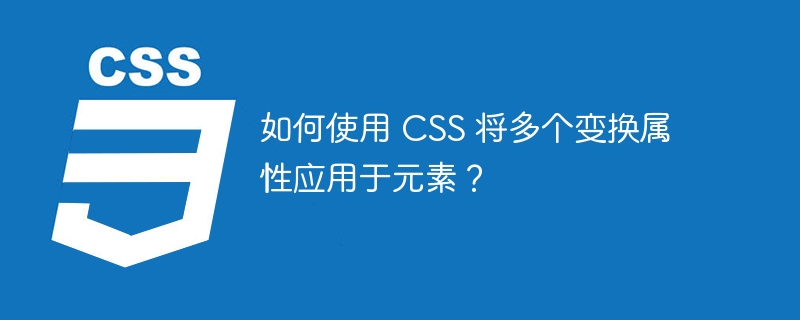

One of the most powerful features of CSS is the ability to apply multiple transforms to an element, which can be used to create stunning visual effects and animations. In this article, we'll discuss how to apply multiple transform properties to an element using CSS, and provide examples of how to leverage this technique to improve your website's user experience.
We'll cover the basic syntax of transform properties, as well as more advanced techniques such as nesting transforms and using multiple transforms to create complex animations. Whether you are a beginner or an experienced web developer, this article will provide you with the knowledge and skills you need to take your CSS skills to the next level.
CSS transform Properties enable developers to apply various transformations to HTML elements, such as scaling, rotation, skew, and translation. transform The properties are very versatile and allow for creative and dynamic design on web pages.
element{
transform: rotate() | scale() | skew() | translate();
}
Let’s take an example of rotating an HTML element using the transform attribute. To rotate an element, we use the rotate function, which takes an angle value (in degrees) as its argument. Here is an example -
<html>
<div class="rotate"> Column </div>
<style>
.rotate {
background-color: orange;
margin: 30px;
width: 70px;
height: 90px;
transform: rotate(45deg);
}
</style>
</html>
To apply multiple transform properties to an element, you simply include each transform property you want to apply in the same CSS rule, separated by spaces.
For example, let's say you want to apply a rotation and scaling effect to an element. Let's take a look.
<html>
<head>
<style>
.rotate {
background-color: orange;
margin: 50px;
width: 70px;
height: 60px;
text-align: center;
letter-spacing: 1px;
}
.rotate:hover {
transform: rotate(65deg) scale(1.5);
}
</style>
</head>
<body>
<h1>CSS Transform Properties</h1>
<h3>Given below is a div element which is rotated by 65deg as well as scaled up by 1.5 on hovering.</h3>
<div class="rotate"> Column </div>
</body>
</html>
In the above example, the .rotate selector locates the element to be transformed, and the transform attribute contains both rotate and scale Functions are separated by spaces.
Therotate function applies a 65-degree rotation to the element, while the scale function scales the element to 150% of its original size. Transform properties are applied when you hover over the element.
The shorthand syntax allows you to include multiple transformation functions in a single transform attribute by separating them with commas.
This is an example. Here, the rotate function applies a 65-degree rotation to the element, while the scale function scales the element to 150% of its original size. translate The function moves the element 40 pixels to the right and 35 pixels down from its original position. Transform properties are applied when you hover over the element.
<html>
<head>
<style>
.rotate {
background-color: yellow;
margin-left: 80px;
width: 70px;
height: 60px;
text-align: center;
letter-spacing: 1px;
}
.rotate:hover {
transform: rotate(65deg) scale(1.5) translate(40px, 35px);
}
</style>
</head>
<body>
<h1>CSS Transform Properties</h1>
<h3>Given below is a div element which is rotated by 65deg as well as scaled up 150 times on hovering. Also, it translates by 40px and 35px.</h3>
<div class="rotate"> Column </div>
</body>
</html>
Let's create an animation that flips the card over to show its back when clicked. You can achieve this by using multiple transforms in CSS along with some keyframe animation.
<html>
<head>
<style>
.card {
width: 200px;
height: 300px;
position: relative;
transform-style: preserve-3d;
transition: all 0.6s ease-in-out;
}
.card .front {
position: absolute;
width: 100%;
height: 100%;
backface-visibility: hidden;
background-color: #FFFDD0;
}
.card .back {
position: absolute;
width: 100%;
height: 100%;
backface-visibility: hidden;
background-color: #FFDEAD;
transform: rotateY(180deg);
}
.card:hover {
transform: rotateY(180deg);
}
.card:active {
transform: rotateY(180deg) scale(0.8);
}
@keyframes flip {
from {
transform: rotateY(0deg);
}
to {
transform: rotateY(180deg);
}
}
@keyframes shrink {
from {
transform: rotateY(180deg) scale(1);
}
to {
transform: rotateY(180deg) scale(0.8);
}
}
.card:active {
animation: flip 0.6s ease-in-out, shrink 0.6s ease-in-out;
}
</style>
</head>
<body>
<div class="card">
<div class="front">
<h2> Front Side </h2>
<p> Hello World!! This is the front side of the card. Hover on me to see the back side. </p>
</div>
<div class="back">
<h2> Back Side </h2>
<p> Hello World!! This is the back side of the card. </p>
</div>
</div>
</body>
</html>
When the front card is hovered, we can see the back of the card.
Card is a container containing two child elements, .front and .back, which represent the front and back of the card respectively. The .front and .back elements are absolutely positioned inside the .card container, and their backface-visibility property is set to hidden to prevent them from being visible when facing the user.
When a card is hovered over, it will flip over to reveal its back. When you click on a card, it flips and shrinks to 80% of its original size.
Flip animation will cause the card to rotate 180 degrees in 0.6 seconds, shrink animation will cause the card to shrink to 80% of its original size in the same time period.
When the card is clicked, both animations are applied simultaneously, creating a complex animation that includes multiple transforms and transitions between the front and back faces.
In this article, we learned that applying multiple transform properties using CSS is a simple way to create complex animations and effects of HTML elements. Using the transform attribute, you can apply various transformations, such as scaling, rotation, tilt, and translation, to any HTML element on your web page. By combining multiple transform properties, you can create more dynamic and attractive designs.
The above is the detailed content of How to apply multiple transform properties to an element using CSS?. For more information, please follow other related articles on the PHP Chinese website!




